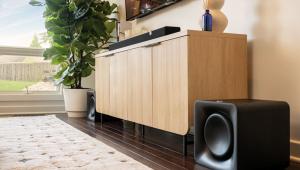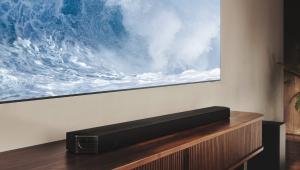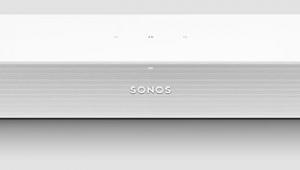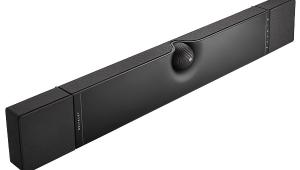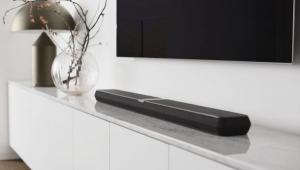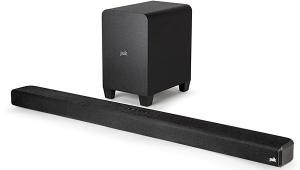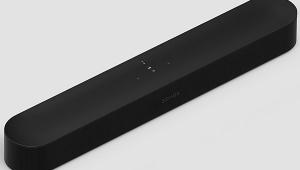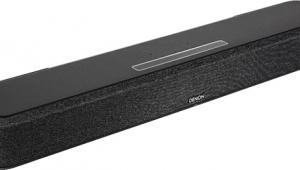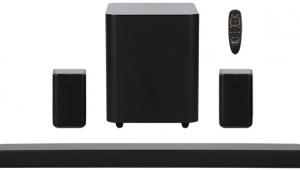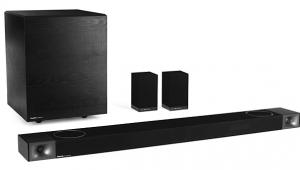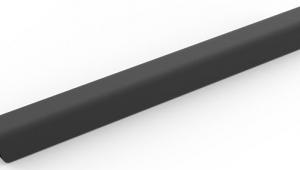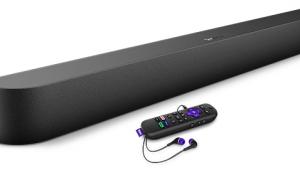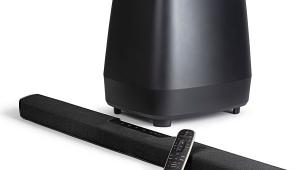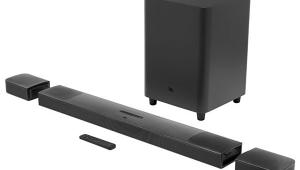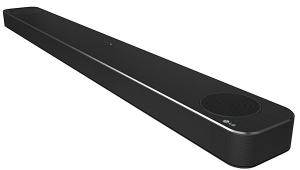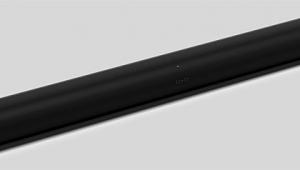A panoramic view is also proposed for multi-media, cross-scale applications to outline overview. - Review Solution
B&W Panorama 2 Soundbar System Page 2
Despite the Panorama 2’s impressive low bass specs (for a soundbar), it includes a line-level output for a separate subwoofer. The PV1D that arrived with the Panorama 2 is unusual, to say the least. To begin with, it’s a 13.5-inch-high, matte black sphere—well, mostly a sphere, at least. Two symmetrical sections on the left and right have been lopped off with each one replaced by an active, 8-inch, paper-Kevlar/aluminum composite-coned driver. A little part of the bottom is gone, too, so the sub will stay in place and not roll around on the floor. Hidden underneath the sub in this area are the line- and speaker-level inputs. There are also connections for two 12-volt triggers (one for on/standby, the other for preset switching) and a connection for RS-232 automation control. Inside is a 400-watt Class D amp, and on the front is a control panel/display window. While I originally thought the Panorama 2 was hefty, that was before I lifted the 41 pounds belonging to the PV1D’s sealed enclosure. Somewhat frighteningly, B&W rates this small, unorthodox sub down to 7.5 hertz (3 decibels down with no conditions of test specified, presumably at low volumes). Keeping that spec in mind while looking at the PV1D, I couldn’t help but think that either my eyes were deceiving me or that B&W’s testing gear had deceived them. [Ed. Note: Apparently the latter; see our still quite respectable lab measurements.]

Like the Panorama 2, the PV1D has been the beneficiary of an extensive overhaul. B&W says the updated version has kept the structurally inert pressure vessel shape with its opposed balanced drivers that work to cancel unwanted vibration. The drivers and amp are new designs, however, and the PV1D now includes a dynamic EQ circuit with four preset levels. The touch-sensitive OLED panel on the front lets you access many of the preset configurations, but all sorts of setup options—including low-pass filter adjustments, output level, EQ preset choice, etc.—are accessible using the custom PV1D version of B&W’s SubApp PC software. (B&W kindly includes the special USB-to-3.5mm cable required to connect a PC to the PV1D.)
An Ovalutionary Remote Control
B&W promotes the Panorama 2 as being almost plug-and-play, and it is one of the simplest soundbars to install and use. It has an unadorned onscreen menu for making tone control adjustments and other one-time parameter setup entries, such as distance from the listening position to the subwoofer and the individual reflective characteristics of the left and right side walls (soft, medium, or hard). Unused inputs are automatically disabled, so you won’t ever find yourself sitting in front of the Panorama 2 wondering why nothing is playing only to find out your four-year-old switched to input #2 and your BD player is connected to input #1. All in all, I found the Panorama 2 to be one of the most stupidly simple, idiot-proof soundbars I’ve ever worked with. And I mean that as a truly high compliment.
 If there’s any area where the Panorama 2 disappoints, however, it’s the soundbar’s remote control. It’s a shame, too, because the remote’s flattened-egg size and shape make it extremely comfortable to hold and (mostly) to use. But there are several unfortunate design flaws that quickly begin to limit the remote control’s appeal. First of all, the remote isn’t backlit. Considering that it sports a mere seven buttons, that’s not an insurmountable problem—although the buttons are very small. Much more debilitating, though, is that unlike a real egg (flattened or otherwise), the remote is totally symmetrical—which means that, when you pick it up in a darkened room, it’s nearly impossible to tell whether you have the business end of the remote pointed at the Panorama 2 or at your stomach. Impossible, that is, until you realize that no matter how many times you push the volume up button, your belly button doesn’t function very well as an IR repeater. Yes, there’s a small indentation near the front of the remote on the underside; and theoretically this will help you to orient the remote properly. I know this is statistically impossible, but it seemed to me that 87.2 percent of the time when I picked up the remote control it was backward; and, incredibly, this would happen even when I laid the remote down—facing in the correct direction—on the couch cushion next to me.
If there’s any area where the Panorama 2 disappoints, however, it’s the soundbar’s remote control. It’s a shame, too, because the remote’s flattened-egg size and shape make it extremely comfortable to hold and (mostly) to use. But there are several unfortunate design flaws that quickly begin to limit the remote control’s appeal. First of all, the remote isn’t backlit. Considering that it sports a mere seven buttons, that’s not an insurmountable problem—although the buttons are very small. Much more debilitating, though, is that unlike a real egg (flattened or otherwise), the remote is totally symmetrical—which means that, when you pick it up in a darkened room, it’s nearly impossible to tell whether you have the business end of the remote pointed at the Panorama 2 or at your stomach. Impossible, that is, until you realize that no matter how many times you push the volume up button, your belly button doesn’t function very well as an IR repeater. Yes, there’s a small indentation near the front of the remote on the underside; and theoretically this will help you to orient the remote properly. I know this is statistically impossible, but it seemed to me that 87.2 percent of the time when I picked up the remote control it was backward; and, incredibly, this would happen even when I laid the remote down—facing in the correct direction—on the couch cushion next to me.
Of course, a lot of people will probably wind up using some sort of a programmable remote control to operate their TV, the Panorama 2, and the other A/V sources in their system. If he were still around, Dante could write an entire chapter devoted to the layer of Hell that is filled with various programmable remotes, though. Thankfully, the Panorama 2 has a feature that’s pretty rare to find on nearly any soundbar, and one that’s clearly directed at the custom electronics installer: RS-232 automation control capability. B&W doesn’t make a very big deal about it, but there’s a 3.5mm minijack on the back of the Panorama 2 labeled Service. While it is, indeed, a service port, B&W offers a small adapter box that allows the Panorama 2 to use the port to communicate via RS-232 with some automation systems. In my case, I test-drove the Panorama 2 using an HC-250 controller from Control4, and I’d recommend spending the not-so-insignificant (over $1,000 plus install and programming) additional cost without hesitation because it allows you to operate the entire system with an incredibly intuitive system remote control (Control4’s SR-250) and potentially expand the system to control lighting, thermostats, and even integrate voice-activated operation of everything, including the Panorama 2.
The PV1D also includes RS-232 integration, which means you can have different EQ curves and level settings for music listening and movie watching that will automatically kick in based on what source or media scene you select. Although you could do much of this with an IR-enabled universal remote, the beauty of RS-232 control is that the components will communicate their status back to the controller, which results in much more reliable system operation. IR control is usually one-way, so the universal remote has to assume that the controlled component has received the particular command (or macro set of commands) and acted accordingly. As anyone who has ever worked with such a setup knows, this doesn’t always happen the way it’s supposed to.
A Mucked-Up Mishmash?
Super-slick command and control, though, isn’t worth diddly squat if the system sounds like crap. With any multi-driver thingamabob using fancy digital signal processing to make up for the fact that all the drivers are packed together in a single cabinet much closer than ought to be legal, there’s always the risk of two-channel music being turned into an overprocessed time-delayed, mucked-up mishmash of mush. The sound from the Panorama 2 has none of that. It’s a high-performance music system in its own right, and one that’s more than worthy of its highly respected heritage.
I had my doubts that a soundbar incorporating a single tweeter could have any hope of decent stereo reproduction. Doubts soon dissipated like the back waves off the Panorama 2’s aluminum dome down the tweeter’s tapering tube, though. The Panorama 2/PV1D is the active soundbar/subwoofer combo to beat when it comes to music. There is a surprising subtlety and pinpoint character to the sound that sucks you in and won’t let go. Even by itself, the Panorama 2’s bass output is mighty impressive, being full, rich, and snappy. Adding in the PV1D takes it to another level entirely, and I found no sense of sub localization at all. It’s the most seamless, most thoroughly impressive active soundbar package I’ve ever heard.
Unlike a lot of soundbars, the Panorama 2 doesn’t attempt to stretch the two-channel soundstage down the sides of the room. Instead, it concentrates on providing a very rich and detailed palette of sound across the front of the room. As a result, there is almost none of the comb filtering you hear with other soundbars as you move from one listening position to another. And, while it’s not perfect, the imaging is extremely stable from one location in the room to another. Processing artifacts are minimal, even when using the Dolby ProLogic II setting—probably because no attempt is made to create a 180-degree (or larger) soundstage. What actually happens is an increase in depth rather than width. Carla Lother’s “100 Lovers,” for instance, blossoms with DPLII engaged. Although Lother’s voice remains mostly unchanged in character and location, the instruments can be heard to shift slightly to positions behind and away from her voice; and there’s a touch more snap to the strings and the drums, as if a lens has brought everything just a bit more in focus. I’m still up in the air as to whether or not I liked the effect with the late Michael Hedges solo guitar on “Because It’s There.” Without multiple instruments to space out and add depth, the processing extracted the ambience present in the recording, with the result being a touch more echo than I would have preferred.
No Soundbar Should Sound Like This
The musical performance of the Panorama 2 is excellent, but the cinematic experience it creates is absolutely stunning—and well beyond what any other active soundbar I’ve ever heard has been capable of. The smooth sweep of the Panorama 2’s soundfield is phenomenal, extending from what appears to be high in the room behind your head to the left all the way to the opposite position on the right. No, it’s not a replacement for the real deal of dedicated surround speakers, but in my experience it’s about the closest you can get at the moment. There is a scene, for example, early on in Immortals, in which a tubular gong is being rung to call out the townspeople to the village center. The camera’s perspective gradually moves backwards through the gong as it’s being hammered, and it’s uncanny how much the Panorama 2 makes it sound as if you are traveling through the ringing tube. The vibrations truly seem to begin behind your head and then move forward through the room. It’s not 100-percent perfect, because there is a slight sensation that the phasing of the rear-emanating sound is being manipulated. It is, however, the most spectacular, utterly believable virtual surround I’ve ever heard. With the PV1D providing such a solid, extremely low bass underpinning, it’s an incredible movie system.
The expansive surround field was equally stunning in The Green Hornet, especially during the first fight scene after the street gang jumps a young couple as the future Green Hornet looks on. As Kato comes high-kicking to the rescue, weapons, gang members, bullets, and appendages fly throughout the room in a way that’s just shy of what most traditional systems with surround speakers could do. After the fight, as they are speeding away, Kato spins the car in a 180 to avoid a police cruiser. The car almost, but not quite, spins across the back of the room. It’s incredibly sensational. Some following scenes featuring exploding meth labs and fire belching from the Black Beauty didn’t even begin to strain the PV1D. In fact, the PV1D’s sound was so tight and powerful, I’m not sure there’s much of anything that would tax it.
Conclusion
Some people might think it’s crazy to spend $2,200 for an active soundbar. Those same people would think it’s even crazier to spend $3,900 for an active soundbar with a sphere-shaped subwoofer. But the only way they’ll think that is if they don’t listen to the Panorama 2—and, especially, the Panorama 2 with the PV1D. B&W has never made a name for itself as a builder of inexpensive speakers. That’s not where they live. But they can usually be counted on to make some of the best-sounding speakers in whatever (usually upper) price range they happen to be in. Though they’re not cheap, I think B&W has outdone itself with the Panorama 2 and PV1D, and the Panorama 2—with or without the PV1D—is unquestionably worth every penny. Quite a bit more, in fact. In terms of style and beauty, music and movie performance, and ease of setup and use, the Panorama 2 is the soundbar all other soundbars wish they could be.
- Log in or register to post comments

